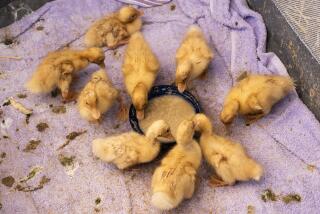Goose Spruce-Up
- Share via
The 15 nature lovers walking hunched over in the rain Sunday weren’t looking for that rare species of bird or traces of a coyote trail along the gravel roads of the Chatsworth Reservoir. They were looking for trash.
It was the first of what organizers hope will be an annual cleanup at the 1,300-acre property, home of a drained reservoir and abundant wildlife, which last year the city set aside as wild lands. But its new status hasn’t stopped trash from trespassing its gated boundaries.
“Stuff comes flying out of cars,” Kathy Nevins said as she picked up Styrofoam cups, plastic sports bottles and fast-food wrappers along a stretch of the reserve that borders Valley Circle Boulevard.
As a flock of mallards flew overhead, Jarron Lucas, co-founder of the Southwest Herpetology Society, called it “goose weather.” The reservoir is home to the only undisturbed wetlands in the San Fernando Valley, said Lucas, whose group co-sponsored Sunday’s cleanup with the Canada Goose Project.
Built in 1919, the reservoir has been empty since 1969 when it was drained for enlargement. But after the 1971 Sylmar-San Fernando earthquake, it was determined that the reservoir’s dam was unsafe and that it sat on a seismic fault.
Over the last three decades, the site has become “the last refuge” for wildlife, especially those being squeezed out of their natural habitats, said David Ecklund, a naturalist with the California Native Plants Society, which participated in the cleanup.
The reservoir is a winter stop for many migratory birds, including the Canada goose.
Ten years ago, members of the Canada Goose Project counted almost 2,000 of the birds in the reserve, said Rosemarie White, president of the Valley-based group. Today, there are about 900, she said.
“They tell us about the balance of nature,” White said of the birds that migrate from as far away as Alaska and Alberta, Canada. The reserve is bordered by tract housing and commercial strips.
Lucas was particularly concerned about the presence of Styrofoam because it clogs the digestive system of birds.
“It gives them a full sensation, so they don’t eat anything else and starve to death,” he said.
Retired wildlife officer Dennis Kroeplin was disturbed by another discovery: the remains of a deer, without hide and legs, apparently a victim of poaching. He recalled the days when he could count several deer.
“Now if you see one you’re lucky,” he said.
It was findings like these that left many of Sunday’s volunteers suggesting guided walks of the preserve to increase public awareness about the site. Cleanup sponsors hope to involve local youth groups, such as the Boy Scouts, to educate young people about the area.
“This is our heritage,” said Ecklund as he pointed out the remains of a Chumash Indian site. And under centuries-old oak trees lay several species of lush plants used by the Chumash, he said, for medicinal and ceremonial purposes.
“It’s an oasis right in the middle of suburbia.”
More to Read
Sign up for The Wild
We’ll help you find the best places to hike, bike and run, as well as the perfect silent spots for meditation and yoga.
You may occasionally receive promotional content from the Los Angeles Times.






